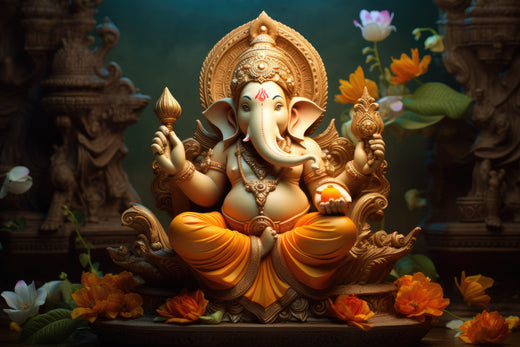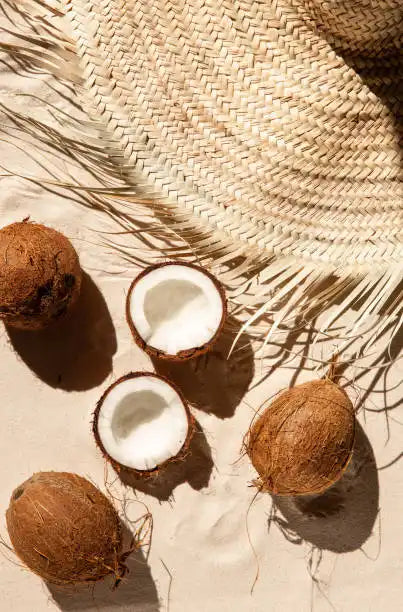
The Significance of Virgin Coconut Oil in Panchkhadya Recipe for Ganesh Chaturthi
Share
Ganesh Chaturthi is a joyous Hindu festival that is celebrated with great enthusiasm across India. In the charming coastal state of Goa, this auspicious occasion takes on a unique and vibrant character, blending religious devotion with cultural celebrations. Many rituals take place during this holy festival. One such ritual that holds immense significance is the preparation of Panchkhadya, a sacred prasad offered to Lord Ganesha. Every person has their way of preparing Panchkhadya. Central to this ritual, coconut is the main ingredient to prepare Panchkhadya. Using virgin coconut oil in Ganesh Panchkhadya as a prasad can enhance the spiritual experience and symbolic significance of the offering. Virgin coconut oil, known for its purity and unadulterated nature, aligns perfectly with the spiritual essence of the ritual. In this blog, we will explore the significance of Virgin Coconut Oil in the Panchkhadya recipe and what are the right ingredients to use while preparing Panchkhadya.
You can also make Modak using the Panchkhadya and offer it to Lord Ganesha. Modak holds a special place in the hearts of devotees, as it is believed to be Lord Ganesha’s favorite sweet. You can incorporate Virgin Coconut Oil into both the outer dough and the sweet filling, infusing the dish with its unique fragrance and flavor. We have mentioned the detailed recipe for Modak in this blog below.
Virgin coconut oil holds a unique and significant role in Ganesh Panchkhadya’s recipe compared to other oils due to its purity, simplicity, and spiritual essence. Virgin coconut oil is extracted from fresh coconut milk without undergoing chemical processes, thus retaining its natural nutrients and aroma. It is as good as offering fresh coconut to God.
Here is why virgin coconut oil is given more importance in Ganesh Chaturthi Panchkhadya than any other oil:
The symbolism of Purity and Sattva: Virgin coconut oil is extracted from fresh coconut milk without the use of heat or any harmful chemicals. This minimal processing maintains the oil’s natural nutrients, aroma, and purity. Ganesh Panchkhadya, being a sacred offering to Lord Ganesha, represents wisdom and purity.
Cosmic Symbolism of the Coconut: The coconut itself is deeply symbolic in Hindu culture, representing the trinity of Brahma (creator), Vishnu (preserver), and Shiva (dissolver). The various parts of the coconut symbolize different aspects of existence. Using virgin coconut oil aligns with this symbolism, as it carries the essence of all three elements: the outer shell, the inner flesh, and the water inside.
Spiritual Essence and Blessings: Virgin coconut oil, in its untouched and pure form, resonates with the spiritual essence of Lord Ganesha. It signifies simplicity, innocence, and a direct connection to nature. By incorporating Virgin Coconut Oil into Ganesh Panchkhadya, devotees convey their humility, sincerity, and genuine devotion, inviting blessings from Lord Ganesha for their endeavors.
Cultural and Traditional Significance: In many Hindu rituals and festivals, coconut and its derivatives are used as offerings, symbolizing auspiciousness, fertility, and abundance. Virgin coconut oil is often used in rituals due to its higher purity compared to other oils, making it a preferred choice for offerings. Ganesh Panchkhadya, being a unique blend of five ingredients, gains an elevated status when virgin coconut oil is used, signifying a blend of purity, auspiciousness, and devotion.
Natural Flavor and Fragrance: Virgin coconut oil can add a pleasant flavor and aroma to Panchkhadya, making it more enjoyable to consume. This could encourage regular use and devotion to the mixture. Its natural fragrance can infuse the offering, creating a deeper connection with the divine. This sensory connection aids in engaging the devotee’s mind, body, and spirit during the ritual.
Cultural Continuity: Hindu rituals often emphasize the continuity of traditions across generations. The use of virgin coconut oil in Ganesh Panchkhadya maintains a link to ancient practices and cultural heritage. This continuity not only preserves the spiritual significance of the ritual but also connects modern devotees with their ancestors’ devotion.
Health benefits: Incorporating virgin coconut oil into Panchkhadya can enhance its health benefits. Virgin coconut oil contains medium-chain triglycerides (MCTs) that provide a quick source of energy. Moreover, its consumption should be part of a balanced diet and a healthy lifestyle.
How Virgin Coconut Oil Should be Used:
Preparation of Panchkhadya: Panchkhadya is a mixture of five ingredients, often including grated coconut, jaggery, sesame seeds, dried fruits, and roasted grams. In the preparation process, virgin coconut oil can be used to lightly roast the ingredients or to coat them, adding a distinct flavor and texture to the mixture.
Recipe of Panchkhadya for Ganesh Chaturthi
Ingredients:
1 cup freshly grated coconut
1/2 cup roasted grams
1/2 cup dried fruits
1/2 cup jaggery, grated
1/4 cup sesame seeds
1/4 teaspoon cardamom powder
Virgin coconut oil for roasting
Instructions:
Heat a pan over medium heat and dry roast the grams, dried fruits, and sesame seeds in virgin coconut oil until they turn golden brown and become crispy. Set aside to cool.
In the same pan, add the grated coconut. Roast it for a few minutes. Be careful not to burn them.
Add grated jaggery and cardamom powder to the coconut mixture and mix it well
Add roasted gram, peanuts, and sesame seeds. Mix well.
Panchkhadya is ready
Place the Panchkhadya, along with other offerings, to present as prasad to Lord Ganesha during the Ganesh Chaturthi puja.
Recipe for Modak
Ingredients:
For the outer covering:
- 1 cup rice flour
- 1 cup water
- A pinch of salt
- 1 tablespoon virgin coconut oil
For the filling
You can use the same Panchkhadya ingredients
Instructions:
- In a saucepan, bring 1 cup of water to a boil.
- Add a pinch of salt and 1 tablespoon of virgin coconut oil to the boiling water.
- Reduce the heat to low and gradually add 1 cup of rice flour while continuously stirring to avoid lumps.
- Cook the mixture for a few minutes until it comes together as a dough. Turn off the heat and let it cool.
Prepare the Filling
Follow the same procedure as the above Panchkhadya method.
Shaping the Modak
- Take a small portion of the rice flour dough and roll it into a smooth ball.
- Flatten the ball between your palms to form a small disc.
- Place a spoonful of the filling mixture in the center of the disc.
- Gently bring the edges of the disc together to cover the filling, shaping it into a modak. You can pinch the edges to make them look like petals.
- Repeat this process to make more modaks with the remaining dough and filling.
Frying the Modak:
- Heat virgin coconut oil in a deep frying pan or kadai over medium heat.
- Once the oil is hot, gently slide the modaks into the hot oil one at a time. Be cautious not to overcrowd the pan.
- Fry the modaks until they turn golden brown and crisp on all sides.
- Remove the fried modaks using a slotted spoon and drain excess oil on a paper towel.
- Fried modaks are ready to offer to Lord Ganesha. Enjoy your delicious Fried Modak made with virgin coconut oil!
To conclude, using virgin coconut oil in Ganesh Panchkhadya and Modak as prasad uplifts the ritual to a higher level of purity, simplicity, and spiritual resonance. It embodies the devotee’s reverence for Lord Ganesha, their desire for well-being, and their intention to offer the best of nature’s gifts. As you engage in this sacred tradition, let the presence of virgin coconut oil deepen your connection with the divine and enrich your spiritual journey.


